13 Best Sites To Sell Photos Online In 2024
Welcome to our roundup of the best websites to sell photos.
Selling photos online can be a great way to make a little extra money on the side. And if you’re super successful at it, it can even lead to a full-time passive income.
In this post, we’ll help you to get started by showing you the 13 best places to list your photos for sale, both as digital downloads and physical prints.
#1 – Your own website
The best place to sell your photos is through your own website, and you can build that website in no time using Sellfy.
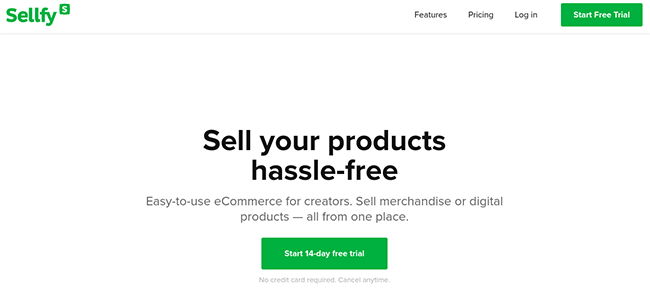
I know what you’re thinking: Why should I bother making my own site when I can just sell my photos through an online marketplace or stock photo site instead?
The answer’s simple: You’ll make more money that way.
When you sell through third-party websites, those websites take a big chunk of all your earnings as their cut. But if you sell through your own site, you keep 100% of your profits (Sellfy charges zero transaction fees).
And you can price your photos however you want, so you can get paid what they’re actually worth and won’t have to sell them for pennies.
There are other benefits too. For example, it makes you look more professional and helps boost your credibility as a photographer. And you won’t have to compete with thousands of other sellers like you would if you sold through popular stock photo marketplaces.
Plus, thanks to Sellfy, creating your own site is easy. Just sign up, upload your photos as a digital product, and set your pricing and license terms.
Once you’ve done that and connected a payment processor, you’re ready to start selling. The whole process can take less than an hour.
Another cool thing is that with Sellfy, you’re not limited to just selling photos as digital files. You can also sell physical prints, or even upload your photos to merch in Sellfy’s print-on-demand catalog and sell that merch through your store.
#2 – Shutterstock
If you want to sell stock photos, Shutterstock is probably your best option. It’s the largest and most well-known stock photo site in the world, with millions of regular customers, which makes it easier to make sales.
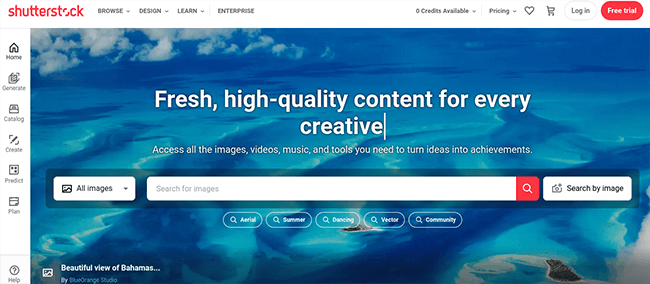
Once you’ve submitted your content to Shutterstock and it’s been approved, it’ll be live on the marketplace. If a customer chooses to license it, you’ll earn up to 40% commission on the sale.
However, the exact commission rate varies depending on the number of licenses you’ve sold that year. You’ll only earn 15% per license for your first 100 sales, then 20% from 101 to 250, etc. You need over 25,000 licenses to earn the full 40%.
Ultimately, it’s a numbers game on Shutterstock. You probably won’t earn much on each sale, but if you have a high volume of stock photos out there, you can potentially sell hundreds every month. And that all adds up quickly.
Just keep in mind that Shutterstock is very competitive. You’ll be competing with thousands of other stock photos, including a lot of free options, so try to be creative and do something new and original to carve out your own space in the market.
#3 – Vecteezy
Vecteezy is an online marketplace for vectors, stock photos, and videos. Like Shutterstock, it gets millions of visitors, so your photos will have high visibility.
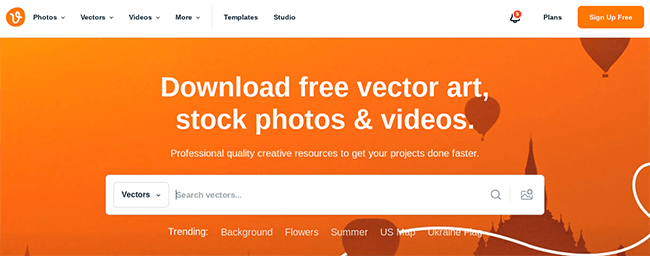
Anyone can sign up as a contributor on Vecteezy. You’ll need to apply first by sharing a few of your best photos with their team. Once you’re accepted, you can start uploading photos and earning money.
The amount you’ll earn will depend on the royalty program you’re signed up for.
On the Free program, you’ll earn $5 for every 1,000 downloads your photos get. That’s not a lot, so you’ll probably need to upload a lot of photos to stand a chance of earning a good income.
The Pro program offers much fairer compensation. It uses a subscriber share model, in which the money Vecteezy customers pay for their subscription is split 50/50 between Vecteezy and the contributors whose images/videos/vectors they download.
So for example, let’s say that a customer is signed up to Vecteezy’s unlimited plan for $14/month. Now let’s imagine that the same customer downloads just 2 photos in that month: one of yours, and one from another contributor.
In that case, 50% of the subscription revenue ($7) would go to Vecteezy, and the other 50% would be split between you and the other contributor, so you’d both earn $3.50 each.
#4 – Envato Elements
Envato Elements is a subscription-based marketplace where users can pay for a monthly subscription, which lets them download unlimited creative assets, including stock photos, videos, graphics, sound effects, and more.
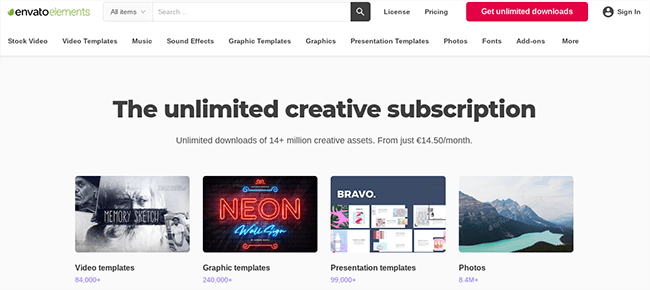
Envato Element offers the same kind of subscriber-share earnings model as Vecteezy’s Pro plan.
Elements contributors (called ‘Authors’) sign up and upload their stock photos to the platform. Then, anyone who’s paid for an Elements subscription can download and use those photos for free.
But every time your photo is downloaded, you’ll earn a percentage of the subscription revenue Envato earned from that customer.
It’s split 50/50 between the platform and the contributors whose assets are downloaded. So if a customer only downloads your photo (and no other assets) in a given month, you’ll earn the full 50% of their subscription payment that month.
If they download 5 photos, including one of yours, you’ll earn 10%, with the other 40% split between the other contributors whose photos were downloaded. You get the idea.
The good news is most contributors find that their photos are downloaded often, so it’s easy to earn money. In fact, Envato says that 98% of their authors earn money every single month. And to date, the Envato community has collectively earned over a billion dollars. Not bad, huh?
#5 – PhotoDune
PhotoDune is a royalty-free stock photo site that’s also under the Envato umbrella. But unlike Elements, it doesn’t follow a subscription model—photos are individually priced.
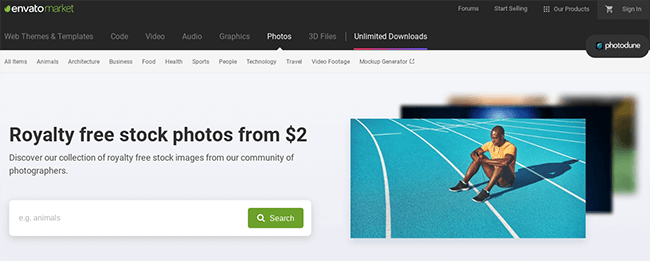
Because you’ll be selling photos individually on PhotoDune, rather than making them freely available for download to anyone with a subscription, you’ll be paid a commission per sale rather than earning through a subscriber-share model.
The amount you’ll earn will depend on whether you choose to sign up as an exclusive author or a non-exclusive author. Being an exclusive author means they can’t sell the photos they sell through Envato elsewhere, whereas non-exclusive authors can.
For non-exclusive authors, Envato takes a 55% cut of each sale and the rest goes to you. For exclusive authors, they only take a cut of 12.5% to 37.5% (depending on how much you’ve sold) so you’ll earn more per license sale.
While you’ll typically earn more from a sale on PhotoDune than you would for a download on Elements, it is a little tougher to make sales. According to Envato, only 37% of their contributors earn in any given month, so you’ll need to be in the top third to make money.
#6 – Etsy
Etsy is best known as a handmade/vintage product marketplace where independent crafters sell their wares. But it’s also a great place to sell your photos.

The best thing about Etsy is how popular it is. It’s one of the most successful ecommerce marketplaces in the world with over 90 million active buyers. That’s a huge base of potential customers for you to tap into.
And while many of those shoppers will be looking for hand-crafted products, there’s also a growing market for photography.
In fact, there are over 300,000 photos listed for sale under Etsy’s photography category, and some of the most successful sellers have sold thousands of prints to date.
The best-selling photos on Etsy tend to be cozy prints with an aesthetic that will appeal to Etsy’s core demographic of young women (80% of Etsy shoppers are female).
Also, keep in mind that most Etsy shoppers will be looking to frame them and use them as wall art. Landscape shots and photos of subjects that are trending to do particularly well.
#7 – Pond5
Pond5 is another great place to sell your stock photos. It’s a royalty-free stock photo website with over a million customers and has paid out over $100 million to contributing artists to date.
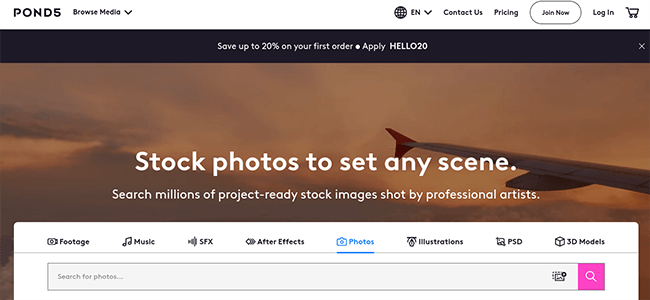
Contributors receive a 50% royalty share on photography sales, which isn’t bad to begin with. But you can bump it up even further with their referral program.
If you refer customers to the platform, you’ll earn 20% commission on their first purchase (or 30% if they purchase your work). That increases your earning potential up to 80%.
Another cool thing about Pond5 is that it lets you create your own customizable storefront. This is helpful if you’re trying to make a name yourself as a photographer. You can choose your own cover photo and profile picture, add a bio, and even link your socials in your Pond5 store.
#8 – Adobe Stock
Adobe Stock is another one of the most popular royalty-free stock photo marketplaces in the world. It has a huge customer base, but it’s very competitive. You’ll be competing with millions of other creative assets.
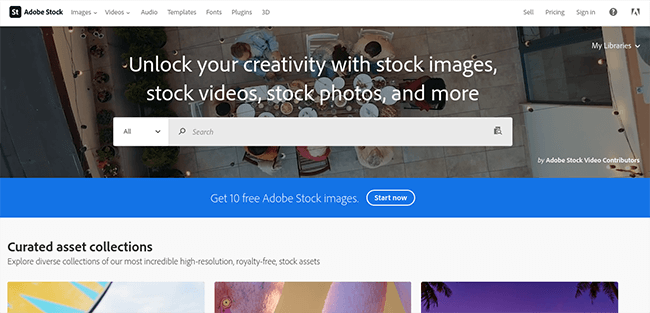
Anyone can sign up as an Adobe Stock artist and start selling, as long as you have high-quality photos that you own all the rights to.
By signing up, you’ll be entering into a non-exclusive partnership, so you’re not locked into one platform and can still sell your photos elsewhere.
You’ll earn 33% royalties per sale, which is pretty low. But Adobe Stock makes up for that sub-par commission rate in its reach. Your photos will get put in front of millions of buyers and be accessible through their favorite Adobe apps thanks to the native Adobe CC integration.
Uploading your photos is a cinch too. You can import whole albums directly from Lightroom or upload them manually through the intuitive Creative Cloud apps.
#9 – Fine Art America
Fine Art America is the best place to sell your photos as prints. It’s a popular print-on-demand marketplace where users can buy wall art from independent artists.

Unlike a lot of the other sites we’ve covered up to now, Fine Art America isn’t a site where you can sell photos as digital downloads. It’s exclusively for selling physical photography products like framed prints and wall art.
Anyone can sign up for free and upload their images to products in Fine Art America’s print-on-demand catalog. There are lots of products to choose from, including canvas prints, posters, etc.
Then, you choose the price you want to sell those products for by adding your markup to the base item cost and list them on the marketplace.
Whenever a customer purchases one of your products, Fine Art America prints and ships it directly to them from the nearest fulfillment center. Then they deduct the base item cost and their cut from the sale price and pay you the rest of the profit.
Order fulfillment is completely taken care of for you, which makes it one of the easiest ways for new sellers to sell physical photography products. And because you don’t need to purchase any inventory upfront, there are basically no startup costs.
#10 – SmugMug
SmugMug is an all-in-one platform for photographers that gives you everything you need to store, protect, share, and sell your photos.
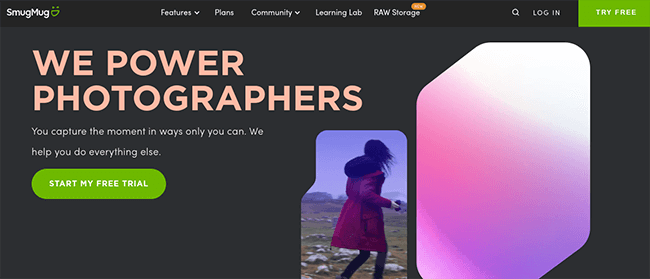
SmugMug offers a bunch of different plans depending on your use case.
To sell photos, you’ll need to sign up for their Portfolio or Pro plan. Once you’ve done that, you can sell both digital downloads and physical prints and set your own profit margins.
You also get a bunch of other useful features, like watermarking and theft protection tools, marketing tools, Lightroom integration for easy uploads, a professional photography website, and unlimited storage.
#11 – Alamy
Alamy is another one of the most well-known stock photography sites on the internet. It’s a great place to sell your photos, as well as videos, vectors, and more.
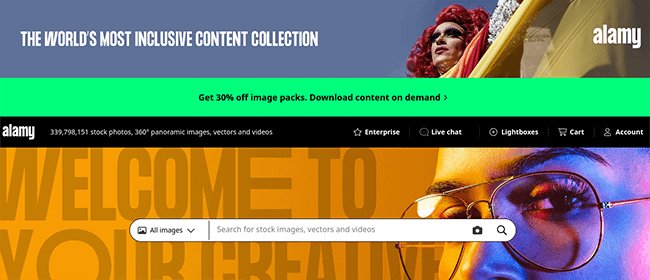
Alamy has paid out over $200 million to its contributors to date. It caters to over 100,000 customers, including big brand names with big media budgets, so there are plenty of sales opportunities.
They offer non-exclusive arrangements and pay up to 50% in commission, which is better than many of its competitors.
You’ll also find a good variety of photos on Alamy—their collection is very broad—so it’s suitable for pretty much any niche. The more creative and unique your photos, the better.
The signup process is straightforward enough. Just fill out some details and link your socials, and wait for Alamy to review and approve your account. Then, you’re ready to start selling.
#12 – Getty Images
Getty Images is a royalty-free image and video marketplace that caters to the higher end of the market.
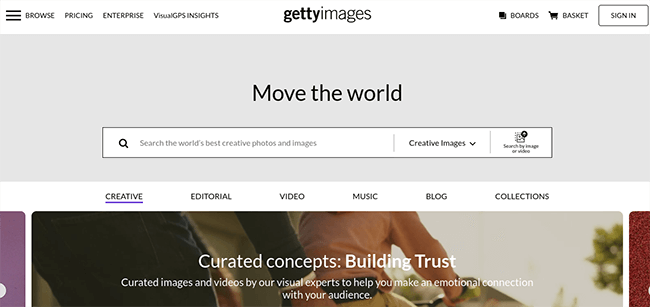
Because Getty Images caters to clients with big budgets (think advertising agencies, publishers, and large enterprises), licenses often sell for hundreds of dollars. As such, it can be super lucrative. You’ll earn a fantastic income if you can create something that Getty customers want.
That said, with high prices come high standards, and high competition. You’ll need to submit 3-6 images to Getty to apply as a Contributor, and there are no guarantees you’ll be accepted.
But if your application is successful, you’ll be able to list your photos for sale and will earn royalties of 15-45% on each file license.
Getty Images offers both exclusive and non-exclusive arrangements.
#13 – WunderPics
Last but not least, we have WunderPics—the best place to sell action sports photos.
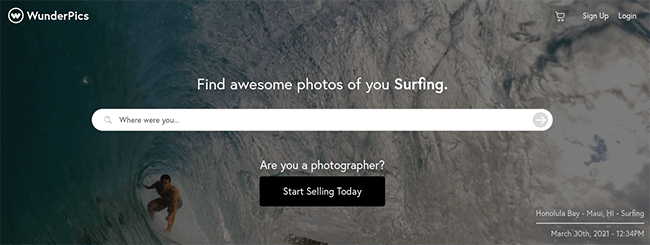
WunderPics works differently from other photo sites. It focuses on one specific niche: sports photography.
The way it works is that sports photographers go out and take shots of people in the middle of the action. For example, that might mean taking a photo of a snowboarder as they head down the slopes, or a surfer catching a wave in the middle of a competition.
They then take those shots and upload them to WunderPics. And they tag them with all the information their subjects will need to find them: the location of the photo, the date and time, etc.
Athletes who want to purchase a photo of themselves in the midst of the action can then search WunderPics to find and buy them.
You can sell photos on WunderPics for whatever price you want, and the platform takes a small 15% commission fee on each sale.
Frequently asked questions
Before we wrap up, here are some frequently asked questions and answers about selling photos online.
How much can I earn selling photos online?
It depends on how successful you are. The most successful sellers earn six-figure incomes selling photos online, but at the other end of the spectrum, the least successful might only make a few bucks per month.
It also depends on the type of photos you sell. If you’re selling stock photography on microstock sites like Shutterstock, you’ll typically only earn a very small amount ($0.10-$0.20) each time your photo is downloaded. So you’d need to get thousands of downloads a month to make a decent income.
On the other hand, if you’re selling licenses or prints through your own website, you can charge a lot more, so you might be able to make a full-time income with a few dozen sales a month.
Are stock photos still profitable?
Stock photos aren’t as profitable as they used to be a few decades ago; the market is a lot more saturated these days. But it’s still possible to make a living from stock photography (or at least a good side income) if you can find a gap in the market.
Anecdotally, some stock photographers on Reddit still report making hundreds of dollars a month from their stock photos even in 2023. It helps to have a large catalog of photos for customers to choose from to maximize your sales opportunities.
What type of photos sell best?
There’s a market out there for pretty much every type of photo, so my main advice would just be to stick to whatever you enjoy shooting.
However, if you’re focusing on selling stock photos specifically, it might be worth focusing on more unusual or unique subjects in order to find a gap in the market that isn’t already oversaturated (nobody needs another stock photo of office workers shaking hands, for example).
What do I do if someone steals my photos?
It’s always worth taking measures to prevent others from stealing your photos, such as watermarking your stock images.
If you notice someone’s stolen your work and is reselling it on stock photo sites without a license to do so, you can try reporting it to the website it’s listed on. Other options include sending an email to the seller, filing a DMCA takedown notice, or hiring a copyright attorney.
Note: We’re not lawyers, so make sure you get legal advice from a qualified professional before you make any decisions.
How can I sell photography as a service?
You can sell photography services through your own website, or through freelance platforms like Fiverr and Upwork.
Note that Sellfy isn’t designed for selling services, so if you plan on going down this route, you may be better off using another ecommerce platform like Shopify to build your site instead.
How do I market my photos?
There are lots of marketing strategies you can use to sell more photos. Here are some options:
- Social media marketing. Share some of your best snaps on social media platforms like Instagram to try to build a fanbase for your work, then invite those social followers to check out your website where they can buy prints/licenses.
- SEO. If you’re selling photos through your own website, optimize it for search to drive organic search traffic.
- Email marketing. Build an email marketing list and use email marketing to nurture leads and promote your photos.
- Paid ads. Run Facebook Ads and Google Ads campaigns to drive traffic to your photo store.
- Offline promotion. Hand out business cards to promote your photo store offline. You can also try promoting it at photography events etc.
Choosing the best websites to sell photos online
That concludes our roundup of the best stock photo websites.
Overall, the best place to sell your photos is on your own stock photography site, which you can build using Sellfy.
But if that seems like a lot of work and you’d rather just sell them through a third-party stock photography website instead, we’d recommend Shutterstock.
Interested in selling your photos as prints on merchandise like t-shirts, bags, etc.? Check out our roundup of the best print on demand sites to get started.
Or if you don’t want to sell your photos online after all, check out this post for more digital product ideas that you can sell instead.
Good luck!
Disclosure: If you buy through links on our site, we may make a commission. This helps to support the running of Startup Bonsai.
